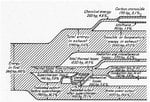I apologize in advance if my question is absurd.
WW2 liquid cooled engines already had cooling systems, radiators, piping, cooling liquid etc. Is it possible to add something like a sterling engine on cooling system, and power a supercharger with it for example? Would it add much more weight or compexity or compromise cooling efficiency? They used turbochargers after all, turbochargers also increased complexity, besides they required strategic materials. Exhaust gases and engine heat are two main source of energy inefficiency in piston engines as far as i know. They harnessed one (to a degree) with turbochargers but did nothing for the other main source of energy loss that I am aware of.
I suspect there is a good reason for this, but I want to hear opinions of much more learned members of this forum.
I apologize for my bad English.
WW2 liquid cooled engines already had cooling systems, radiators, piping, cooling liquid etc. Is it possible to add something like a sterling engine on cooling system, and power a supercharger with it for example? Would it add much more weight or compexity or compromise cooling efficiency? They used turbochargers after all, turbochargers also increased complexity, besides they required strategic materials. Exhaust gases and engine heat are two main source of energy inefficiency in piston engines as far as i know. They harnessed one (to a degree) with turbochargers but did nothing for the other main source of energy loss that I am aware of.
I suspect there is a good reason for this, but I want to hear opinions of much more learned members of this forum.
I apologize for my bad English.

